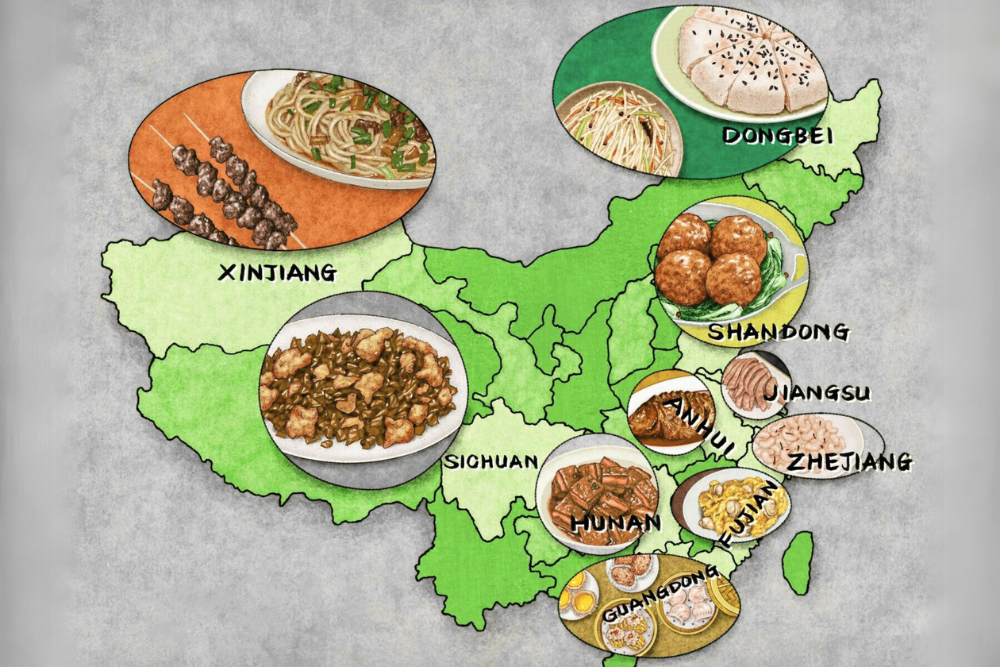Taste the Regions of China: A Flavorful Journey Through Sichuan, Guangdong & Beijing
When you think of Chinese food, what comes to mind? Noodles, dumplings, fried rice? While those are beloved staples, the true magic of Chinese cuisine lies in its regional diversity—each area with its own rich culinary story, signature ingredients, and unforgettable flavors.
Whether you’re planning a trip to China or simply expanding your foodie horizons, this guide spotlights three iconic Chinese regions—Sichuan, Guangdong (Cantonese), and Beijing—and their must-try dishes. Get ready for a sensory journey through the bold, the subtle, and the historic.
Sichuan: Bold, Spicy, and Addictive
If you live by the mantra “the spicier, the better,” Sichuan cuisine will feel like home. This southwestern province is famous for its fiery flavors and the unique numbing sensation of Sichuan peppercorns.
Must-Try Sichuan Dishes:
- Mapo Tofu – Silky tofu in a spicy, chili-laced, peppercorn-rich sauce.
- Kung Pao Chicken – A perfect balance of sweet, sour, and spicy with a satisfying crunch.
- Hot Pot (Huǒguō) – Customize your meal with meats, veggies, and noodles cooked in bubbling broth.
- Dan Dan Noodles – Savory noodles with sesame paste, chili oil, and minced pork.
Sichuan cuisine is all about málà—the addictive combination of spicy heat and numbing pepper. It’s intense, thrilling, and completely unforgettable.
Guangdong (Cantonese): Subtle, Fresh, and Globally Beloved
Located in southern China, Guangdong cuisine—better known globally as Cantonese food—is perhaps the most internationally recognized style of Chinese cooking. It celebrates balance, fresh ingredients, and the natural flavor of food.
Signature Cantonese Dishes:
- Dim Sum – A variety of small dishes like dumplings, buns, and rolls served with tea.
- Char Siu (BBQ Pork) – Sweet, caramelized pork with a distinctive red glaze.
- Wonton Noodle Soup – Clear broth with shrimp or pork wontons and noodles.
- Steamed Fish with Ginger and Soy – A simple, elegant preparation highlighting freshness.
Cantonese food is light, aromatic, and versatile, perfect for those who appreciate subtlety over spice.
Beijing: History on a Plate
Beijing’s culinary tradition is rooted in its imperial history, northern climate, and vibrant street food culture. Expect hearty, wheat-based dishes, bold sauces, and roasted flavors.
Famous Beijing Dishes:
- Peking Duck – Crisp skin, tender meat, and served with pancakes, scallions, and hoisin sauce.
- Zhajiangmian (Fried Sauce Noodles) – Thick wheat noodles topped with a savory fermented bean paste.
- Baozi (Steamed Buns) – Filled with meats or vegetables, perfect for on-the-go meals.
- Luzhu Huoshao – A traditional dish made with pork offal, tofu, and baked wheat cakes—an adventurous favorite among locals.
Beijing cuisine reflects the grandeur of China’s dynastic capital, delivering bold flavor and rich culinary heritage.
Comparing Chinese Regional Cuisines
| Region | Flavor Profile | Signature Dishes |
| Sichuan | Spicy & numbing (málà) | Mapo Tofu, Dan Dan Noodles, Hot Pot |
| Guangdong | Light, fresh & balanced | Dim Sum, BBQ Pork, Steamed Fish |
| Beijing | Hearty & savory | Peking Duck, Zhajiangmian |
Each region tells its own story through food—shaped by geography, climate, history, and culture. Exploring Chinese cuisine by region reveals the stunning complexity and richness of this culinary powerhouse.
Final Word: Where Should You Start?
Not sure which region to dive into first?
- Love bold, spicy flavors? Start with Sichuan.
- Prefer clean, delicate notes? Guangdong is your gateway.
- Crave history and heartiness? Beijing will not disappoint.
The truth is, there’s no one answer to “What is Chinese food?” It’s dozens of cuisines stitched together by tradition and creativity. So go beyond the basics, and let your taste buds explore the full spectrum of Chinese regional cuisine.
Your journey through China begins on the plate. Ready to dig in?






